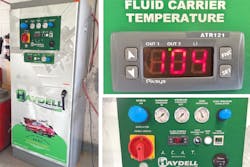eSpray by Haydell Industries
WEBSITE: haydell.com
COST: $30,000-$40,000
USES: Spraying paint
TRAINING: Mike Haydell, president of Haydell, provides technical training support
THE SHOP:
CK Collision Centre is a four-shop Canadian MSO that has locations in the greater Toronto area and one in Cottage Country. The shop opened in 1978 and has maintained its I-CAR Gold Class qualifications since 1987.
THE REVIEWER:
President Terry Bradimore began his career in collision repair as an apprentice. From there, he worked his way up to store manager and eventually purchased his first shop. After learning about mergers and acquisitions, Bradimore found his calling and began expanding.
Bradimore always struggled with humidity in his shop and was looking for a product that would help speed up the paint-drying process.
When Bradimore was disappointed he couldn’t find any products on the market that directly addressed humidity—until his son, Terrence, vice president of operations for CK Collision, told him about eSpray by Haydell Industries.
HOW IT WORKS:
eSpray converts the air in the spray gun hose attached to the machine from compressed into patented blended gas. During the conversion, the eSpray system removes all oxygen, moisture and particulates from the air used in paint guns. The system then ionizes the gas and paint/material mixture and creates a positively charged combination that is attracted to the negatively charged surface. The painter has control over the temperature and air pressure used and once those features are set, the painter can attach the spray gun and begin the job.
THE REVIEW:
“I’ve heard some of my painters say if I ever get rid of this, they’ll quit,” Bradimore says. “How many machines can you say that about?”
Bradimore installed the system in his Bowmanville shop. The plan was to move the system after a short trial period to another shop, but when he went to move it, his Bowmanville painter refused to let him take it away. After getting such a positive reaction, Bradimore ordered the system for the rest of his locations and has received the same feedback from all of his shops.
Bradimore says the system does have an adjustment period, but Haydell president Michael Haydell provided all of CK Collision Centre’s painters his cell phone number in case of questions and personally spent a week with John Dalziel, refinisher at the Bowmanville location, to help him get used to it.
Bradimore says that when using the system, he’s noticed that primer lays down smoother, there’s less overspray, and overall he sees a better refinishing job. The eSpray allows paint to be applied at 110 degrees Fahrenheit, which means Bradimore’s painters can paint wet on wet instead of waiting for clear to dry. The built-in ionizer removes all of the static, which Bradimore says causes metallics to lay down better and results in better overall color matching.
Dalziel adds that the system has fixed CK Collision’s humidity problem. The shops use temperature-controlled booths. These booths pull air in from the outside, which in the hot summer months means that moisture is entering the booths. Dalziel is able to spray at a temperature between 100 and 110 degrees thanks to the temperature setting, which eliminates the moisture problem.
Bradimore’s shops have been using the product for about a year and a half and have seen improved cycle time and reduced material waste.
“This is the biggest game changer our shop has seen since a management system came into our business,” Bradimore says.
THE RETURN:
The results have varied based on shop, but Bradimore says that the MSO has saved an average of 30 percent on clear because the system cuts down on overspray, leading to an overall reduction in wasted materials.
“Everyone in the shop is making more money because we’re able to get more work through,” Bradimore says. “At the Orillia location, painters are coming in earlier to spray and are finishing all of their work by 3:30 p.m. That’s extra time they get to spend with their families.”
Bradimore says that a conservative estimate would be that each shop can easily do three more paint jobs per day, and typically 10 more a week. Terrence says an average repair is around $2,000, which would bring in around $10,000 each week. He reports that sales were up 10 percent six months into the 2016 fiscal year. The only change to the repair process was the addition of the eSpray.
Interested in knowing the impact of a particular collision repair product in the shop? Send your suggestions to [email protected].

